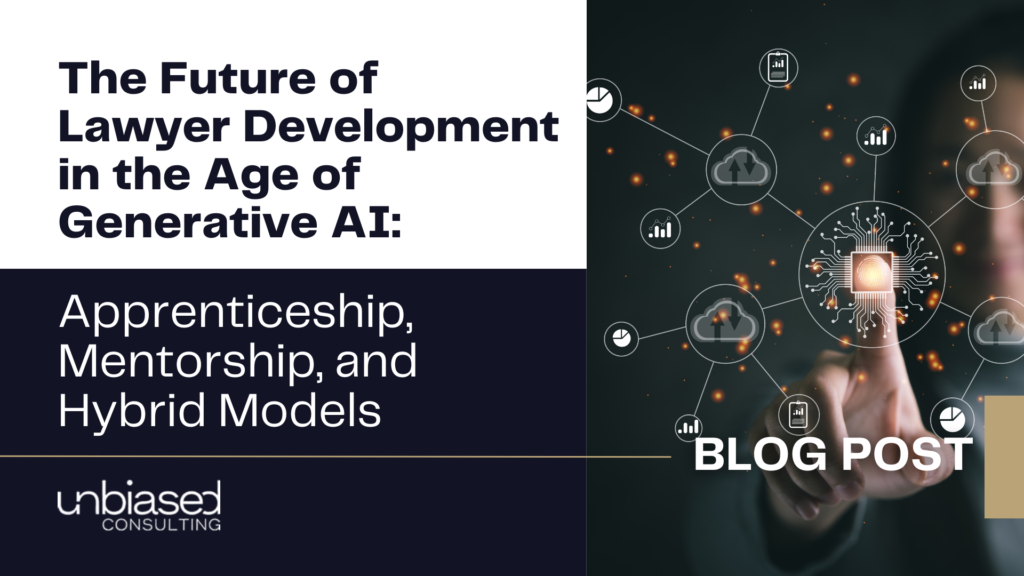The legal profession, long steeped in tradition, is undergoing a seismic shift with the integration of generative AI tools. These technologies promise to reshape how lawyers approach research, drafting, and even client interaction. Amid this transformation, law firms and legal educators must rethink how they develop the next generation of lawyers.
Traditional models of apprenticeship, mentorship, and hybrid approaches each offer distinct opportunities and challenges in this new era. Here, we explore how these models adapt to the evolving demands of the legal profession, particularly in light of generative AI.
The Apprenticeship Model: Tradition Meets Technology
Historically, the apprenticeship model has been a cornerstone of legal training. Junior lawyers work closely under the supervision of senior attorneys, learning the craft through observation, repetition, and correction. In the age of generative AI, this model faces unique opportunities and challenges.
Opportunities:
- Enhanced Learning Tools: Generative AI can function as a virtual mentor, providing instant feedback on drafts, suggesting revisions, or highlighting relevant case law. This allows apprentices to refine their skills more efficiently.
- Focus on Higher-Order Skills: With AI handling routine tasks like legal research or initial drafting, apprentices can focus on developing critical thinking, client advocacy, and strategy.
- Standardization of Training: AI offers consistent resources, such as engineered prompts or practice scenarios (ways of working), reducing variability in training quality across mentors.
Challenges:
- Over-Reliance on AI: Apprentices risk becoming overly dependent on AI, potentially hindering their ability to perform tasks manually when needed.
- Limited Client Exposure: If AI takes over routine interactions, junior lawyers may lose opportunities to build client-facing skills.
- Preserving the Human Element: The master-apprentice dynamic may weaken if AI intermediates too much of the training process.
The Mentorship Model: Accelerating Growth
The mentorship model emphasizes guided independence, with junior lawyers taking on progressively complex tasks. This approach thrives in dynamic environments where adaptability and problem-solving are paramount. Generative AI amplifies this model’s benefits while introducing new considerations.
Opportunities:
- Support for Complex Tasks: Generative AI can assist juniors with challenging assignments by providing suggestions, summarizing precedents, or drafting documents for review.
- Broader Exposure: By automating repetitive tasks, AI allows mentors to assign juniors to diverse projects, accelerating learning and helping them identify areas of interest.
- Strategic Mentorship: Mentors can focus on coaching juniors in areas like negotiation tactics and ethical decision-making, where AI falls short.
Challenges:
- Risk of Superficial Understanding: Rapid task delegation supported by AI might lead to a shallow grasp of legal concepts if juniors rely on AI without fully engaging with the material.
- Inconsistent Oversight: The independence encouraged by this model may result in inconsistent quality of work if senior lawyers do not closely monitor AI-assisted outputs.
- Erosion of Core Skills: Tasks like deep legal research or meticulous drafting may diminish as AI handles these responsibilities.
The Hybrid Model: Balancing Tradition and Innovation
Firms should consider adopting a hybrid approach, combining elements of apprenticeship and mentorship to create a comprehensive development framework. This model is particularly well-suited for integrating generative AI into legal training.
Opportunities:
- Layered Learning: Juniors can start with AI-assisted tasks to gain confidence and foundational knowledge, transitioning to more complex, supervised work over time.
- Dynamic Feedback Loops: AI provides instant feedback on routine tasks, while mentors offer in-depth guidance on higher-order challenges, enhancing learning efficiency.
- Future Preparedness: The hybrid model equips lawyers to critically evaluate AI outputs and make strategic decisions.
Challenges:
- Balancing Independence and Oversight: Striking the right balance between autonomy and supervision can be tricky. Over-reliance on AI risks juniors missing key learning experiences.
- Resource Allocation: Implementing a hybrid model requires investment in AI tools and mentor training, which can strain resources.
- Cultural Resistance: Some senior lawyers may resist integrating AI into traditional training methods, viewing it as a threat to core professional values.
Charting a Path Forward
The age of generative AI demands a reimagining of lawyer development. Law firms and educators must:
- Embrace AI as a Complement, Not a Substitute: AI should enhance—not replace—the learning process. Juniors must be trained to critically evaluate AI outputs and use them for deeper analysis.
- Invest in Training and Resources: Successful integration requires equipping both juniors and mentors with the skills to navigate AI-driven workflows.
- Adapt Models to Individual Needs: Tailoring training to the junior lawyer’s goals, practice area, and learning style ensures effective development.
- Preserve Core Skills: While AI can handle routine tasks, juniors must still develop foundational skills like research, drafting, and client advocacy.
- Foster a Growth Mindset: Encouraging adaptability and lifelong learning will prepare lawyers for the ongoing evolution of the profession.
Conclusion
Generative AI is reshaping the legal profession, presenting both opportunities and challenges for the development of junior lawyers. Whether through traditional apprenticeship, modern mentorship, or a hybrid approach, the key is to balance AI’s efficiencies with the human elements of legal training. Thoughtful integration of AI ensures that the lawyers of tomorrow are not only proficient but exceptional in serving clients, upholding justice, and innovating in a rapidly changing landscape.

